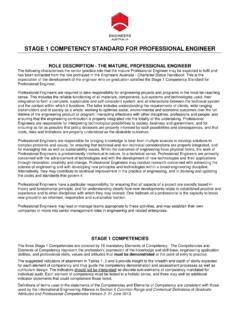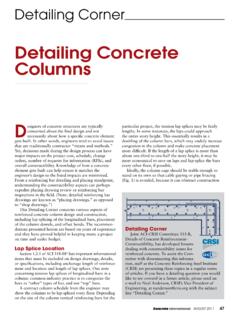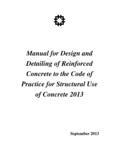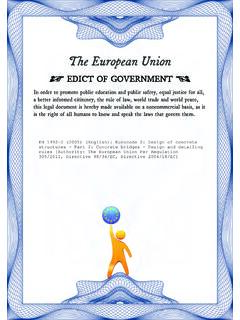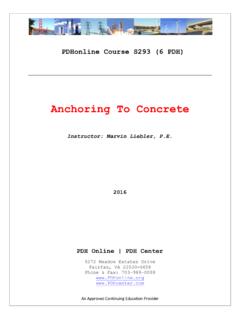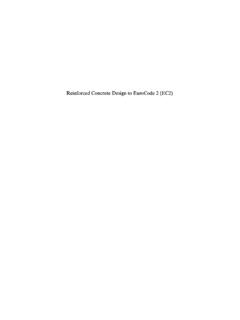Transcription of Detailing of Reinforcement in Concrete Structures
1 THE CIVIL & STRUCTURAL ENGINEERING PANELTHE CIVIL & STRUCTURAL ENGINEERING PANELENGINEERS AUSTRALIA SYDNEY DIVISIONENGINEERS AUSTRALIA SYDNEY DIVISION28 August 2012 Detailing of ReinforcementDetailing of Reinforcementin Concrete Structuresin Concrete Gilbert DetailingDetailingis often considered to be the is often considered to be the preparation of working preparation of working drawingsdrawingsshowing the size and location of the Reinforcement in a showing the size and location of the Reinforcement in a Concrete structure . Detailing Detailing involves theinvolves thecommunication communication of the engineerof the engineer s design to the s design to the contractors who build the structure .
2 Itcontractors who build the structure . Itinvolves the translation of a involves the translation of a good structural design from the computer or calculation pad intogood structural design from the computer or calculation pad intothe the final structure . Good Detailing ensures that Good Detailing ensures that Reinforcement Reinforcement and Concrete interact efficientlyand Concrete interact efficientlyto provide to provide satisfactory satisfactory behaviourbehaviourthroughout the throughout the complete range of range of loading. In this seminar, guidelines for In this seminar, guidelines for successful successful detailingdetailingin structural elements and in structural elements and connections are are :: The Detailing requirementsof a Reinforcement bar depend on thereasons for its inclusion in the structure .
3 Reasons include:1. To carry internal tensile forces, thereby imparting strength and ductility;2. To controlflexural cracking;3. To control direct tension crackingin restrained Structures ;4. To carry compressive forces;5. To providerestraintto bars in compression;6. To provide confinementto Concrete in compression;7. To limit long term deformation;8. To provide protection against spalling; and 9. To provide temporary supportfor other Reinforcement during principles: Determine location and direction of all internal forces( establish a load paththat satisfies equilibrium); Use adequately anchoredreinforcement wherever a tensile force is required for equilibrium; Use only ductile Reinforcement (Class N or better) when the Reinforcement is required for strength; Never relyon the Concrete s ability to carry tension (it may not exist); Include adequate quantities of Reinforcement for crack control.
4 Ensure steel details are practicaland that steel can be fixed and Concrete can be satisfactorily placed and compacted around complex details with adequate cover; and Ensure details are of tension:1. Tension caused by bending (and axial tension):Positive bendingNegative bendingAxial tensionFlexural tension cracksFlexural tension cracksDirect tension cracksSources of tension:2. Tension caused by load reversals:Cantilever beam or slabSimple beam or slabImpact and rebound loadingSources of tension (ctd):3. Tension caused by shear and torsion:CCTTS hearTension carried by stirrupsFlexure shear cracksSources of tension (ctd):4.
5 Tension near the supports of beams:The longitudinal tension at the support is greater than indicated by the bending moment tensile force at the bottom of the inclined crack is equal to the compressive force at the top of the of tension (ctd):LstAS3600 2009 ( ):Sufficient bottom steel must be anchored for a length (Lst) past the mid point of the bearing to develop a tensile force of V*cot v/ (plus any additional force arising from restraint)This requirement is deemed to be satisfied if either Astis extended past the face of the support by 12db; or Astis extended past the face of the support by 12db+ D/2where Astis the tensile steel area required at mid spanSources of tension (ctd):5.
6 Tension within the supports of beams and slabs:Cracking due to inadequate slip joint between slab and supporting brickwallSources of tension (ctd):6. Tension within connections:Hangerreinf. to carry tensionPrimary girderCompression strutsReaction from secondary beam applied hereSecondary beamMMCCTTMM(a) Internal forces (b) Crack pattern2 TSources of tension (ctd):7. Tension at concentrated loads:Sources of tension (ctd):8. Tension caused by directional changes of internal forces:(a)TTTR stirrups(b) (c)C CR Potential crack in webAsvat spacingsSources of tension (ctd):8.
7 Tension caused by directional changes of internal forces:(a)TTTR stirrups(b) (c)Asvat spacingsCTCT rmqtAstmsystmtrfArTq== tension:Required stirrup spacing:Splitting failures around developing bars. F F F T F F F Tensile stresses Splittin Atr Atr Splitting cracks a) Forces exerted by Concrete on a deformed bar (b) Tensile stresses in concreteat a tensile anchorage (c) Horizontal splitting due (d) Vertical splitting due to (e) Splitting (bond) failure insufficient bar spacing.
8 Insufficient cover at a lapped splice. Anchorage of deformed bars is fbAs fsybsybtsyffdL 4. For a Reinforcement bar to reach its yield stress at a criticalcross section, a minimum length of reinforcing bar (an anchorage) is required on either side of the section. AS3600 2009 specifies a minimum length, called the development length, , over which a straight bar in tension must be embedded in the Concrete in order to develop the yield stress. An average design ultimate bond stress fbis assumed at the interface between the Concrete and the reinforcing bar ( = ). fbdepends on type and condition of reinforcing bar; strength and compaction of Concrete ; Concrete cover; bar spacing; transverse Reinforcement ;transverse pressure (or tension).
9 The basic development length, , iswhere k1= a horizontal bar with > 300mm of Concrete castbelow it and k1= for all other bars; k2= (132 db)/100;k3= (cd db)/db(but k3 )cdis the smaller of the Concrete cover to the bar or halfthe clear distance to the next parallel bar;f cshall not be taken to exceed 65 MPaAS3600 2009:( )bdk129 c2bsy =AS3600 2009( )c1ca/2cd= min(a/2, c, c1) The development length be taken as the basic development length or may be refined to include the beneficial effects of confinements by transverse steel or transverse pressureand iswhere k4= 1 K (but k4 ); and k5= p(but k5 ); AS3600-2009ctd( ) FIGURE (B) VALUES OF K FOR BEAMS AND SLABS K = K = K = 0 1 -K where = ( Atr )/As.
10 Atr = cross-sectional area of the transverse Reinforcement along the development length = cross-sectional area of the minimum transverse Reinforcement , which may be taken as for beams and 0 for slabs As = cross-sectional area of a single bar of diameter db being anchored K = is a factor that accounts for the position of the bars being anchored relative to the transverse Reinforcement , with values given below: AS3600-2009ctd( ) The development length Lstto develop a stress stlower thanfsy:When calculating stdon t forget to include the strength reduction factor ( = ).




